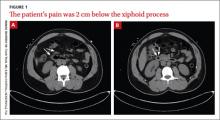Six days after being discharged from the hospital for treatment of acute pericarditis, a 49-year-old man came to our clinic for a follow-up appointment. The patient still had midsternal chest discomfort and dyspnea. He also reported new epigastric abdominal pain, which had begun 2 days earlier. The patient’s wife indicated that he’d had a low-grade fever since discharge, but the patient denied any chills, hematemesis, melanotic stools, diarrhea, or constipation. The patient’s medical history was significant for gastroesophageal reflux, hyperlipidemia, osteoarthritis, sleep apnea, and obesity. Along with newly prescribed indomethacin for the pericarditis (50 mg tid), he was also taking simvastatin. In addition, he occasionally took ibuprofen (800 mg/d) for osteoarthritis of his knee.
On physical examination the patient appeared uncomfortable. Auscultation of his lungs and heart was unremarkable. His abdomen was mildly distended, with hyporesonant bowel sounds and involuntary guarding upon palpation of the upper abdomen. The location of the pain was 2 cm below the xiphoid process. The patient was admitted to the hospital for further work-up, which in- cluded computed tomography (CT) (FIGURE 1A and 1B).WHAT IS YOUR DIAGNOSIS?
HOW WOULD YOU TREAT THIS PATIENT?


